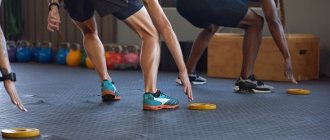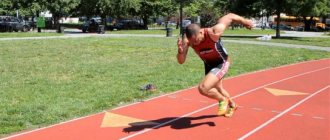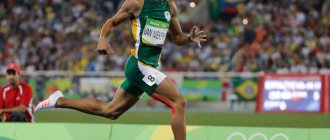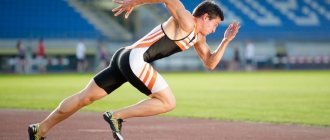The 60-meter run is one of the disciplines in athletics that belongs to sprint running. Included in the list of mandatory standards in all educational institutions: schools, colleges, universities, military academies, etc. The distance is also included in the programs of the European and World Championships and is regulated by the IAAF. However, the distance is not included in the program of the Olympic Games.
Competitions in the 60-meter race are held in athletics arenas, and most often in the winter season. Students in educational institutions take athletics standards in the spring and less often in the fall.
Technique for running 60 meters
A competent combination of theory and practice, harmony of body and spirit will help you achieve amazing results. You shouldn’t endlessly test your endurance while racking up another kilometer. It is important to be patient and follow a certain consistency when performing the exercises. This approach will help you get the most out of your training.
So, you have decided to master the technique of sprinting. Where to begin? What's so difficult about running such a short distance? You won't even have time to get tired. Another thing is long distances. Here you need good physical training, endurance, and willpower... But everything is not as simple as it seems at first glance. Every coach will tell you with confidence that running 60 meters perfectly develops quick reaction and speed in athletes. This helps when preparing for big races.
If you stand at a distance of 60 meters, you will have to overcome four stages:
- Starting stage
- Acceleration moment
- Main stage of running
- Finish stage
Let's look at each stage in more detail.
This is interesting
- [uaf_vkcount url='https://beginogi.ru/metodika-obucheniya-tehnike-bega-na-srednie-distantsii/']
Methods for teaching middle-distance running techniques
- [uaf_vkcount url='https://beginogi.ru/tablitsyi-normativov-po-begu-na-1-km/']
Standard tables for 1 km running
- [uaf_vkcount url='https://beginogi.ru/nauchitsya-begat-100-metrov/']
How to learn to run a fast distance of 100 meters and how to run it correctly
Starting stage
A low start is the best solution when running 60 meters. Usually performed from the starting blocks. In this case, you will be able to push off sharply and gain the desired speed in the first seconds. At the command “Start”, place your strong leg forward. Leaning on the knee behind your standing leg, place your hands on the surface of the path. By the way, many athletes try to avoid such a concept as “strong leg” . It’s worth developing your running abilities harmoniously; if one leg seems weak to you, then you need to give it additional load .
At the “Attention” command, move your center of gravity forward, lifting your pelvis. When you hear the command “March,” push off energetically and begin to actively work with your arms. Don't forget to bend your elbows .
Acceleration moment
Acceleration will be more effective if your body is tilted forward. In this case, body weight will help accelerate. Try to gradually increase the length of your steps and frequency, but do not lift your feet too high. The main emphasis should be on the forefoot, and you can only slightly touch the track with your heel. Remember about active hand movements! Do you feel how quickly you picked up speed?
Main stage of running
The acceleration has stopped when your steps stop changing and become constant . The climax of covering the distance has begun. At this time, the maximum speed has been developed, which must be maintained until the finish.
This is interesting
- [uaf_vkcount url='https://beginogi.ru/tehnika-bega-na-200-metrov-idem-na-rekord-mira/']
How to quickly run 200 meters, train sprinting
- [uaf_vkcount url='https://beginogi.ru/useyn-bolt-rekordyi-i-trenirovka-znamenitogo-rekordsmena/']
Usain Bolt - records and training of the famous record holder
Finish stage
At the last stage, it is important to remain calm. You must complete the race at maximum speed . Don't jump to the finish line trying to save time. On the contrary, you will waste precious seconds on the jump.
Sportbox.by
Chapter 1. Series: Exercises for Runner Training .
Considering running from the point of view of the efficiency and economy of movements of individual parts of the body, and studying the technique of the best runners in the world, one can understand and notice that many of them have differences in the movement of their arms, holding their heads, and even in the movement of their legs.
On the subject: Which treadmills are better, electric or mechanical?
However, in general, all movements of a runner are subject to the general principles of biomechanics, and all are characterized by a common running technique.
It is important to learn the correct, most economical and effective movements, which is why beginner runners need to do the following exercises.
The first exercise for learning running technique.
Running a segment of 60-100 meters. The feet are placed on the line and parallel to it. We make 4-6 episodes.
Second exercise to teach running technique.
Attention!
The same as in the previous exercise, but with the feet placed in front. We perform 4-6 episodes.
Third exercise for teaching running technique.
The exercise is similar to the previous ones, only with a very energetic lifting of the hip forward and upward.
The fourth exercise for teaching running technique.
Run, raising your hips high in place and then moving forward 30 meters. We perform 3-6 episodes.
Fifth exercise for teaching running technique.
Running through objects, such as gymnastic benches, balls, etc. By changing the distance between objects and their height, you can change the frequency and length of the step, the height of the hip, and therefore the rhythm and speed of running.
Sixth exercise for teaching running technique.
Running a segment of 60-100 m with a good end of the back push. We repeat the exercise 5-8 times. To improve the push-off technique, we use slow running with accentuated push-off due to full straightening of the ankle joint.
Seventh exercise for teaching running technique.
Running in jerks with an accentuated push-off, at the moment of which the lower leg, foot and thigh form an almost straight line. We perform the exercise for 30-40 meters in series 4-6.
Eighth exercise for teaching running technique.
The same exercise as the previous one, but with weights. As a weight, you can use a bag or belt with sand, the weight of which is about 5 kg.
Ninth exercise for teaching running technique.
Multi-jumps on one leg with the pushing leg pulled forward and up, as during running, and lowered onto it. We perform the exercise 3-5 times for 20-30 meters.
Tenth exercise for teaching running technique.
Important!
Running with the shins overtaking, the heels touching the buttocks. We repeat the exercise 2-4 times, running 30-50 m.
Eleventh exercise for teaching running technique.
Starting position: main stance. Shift the weight of your body onto your toes without lifting your heels. Run a distance of 15-20 m, maintaining the torso tilt obtained by doing so. Complete 4-7 series.
Twelfth exercise for teaching running technique.
Running a segment of 60-100 m at the entrance to the turn. We perform the exercise 3-5 times. Monitor the smooth entry into the turn, the tilt of the body to the left and forward, and the movement of the elbow of the right hand to the right when moving it back.
Thirteenth exercise for teaching running technique.
The same exercise, but running around a turn.
Fourteenth exercise for teaching running technique.
Run from a low start at a distance of 30-40 m. Repeat the exercise 5-8 times. Pay attention to a quick and powerful push-off while maintaining the starting tilt of the body.
Fifteenth exercise for teaching running technique.
Running from a high start over a distance of 40-50 meters. Complete 5-8 series. Pay attention to the running speed and the exit from the start in a bent position, which is achieved by actively raising and lowering the hip, as well as a powerful push-off.
Sixteenth exercise for teaching running technique.
Running downhill on an inclined path of 4-5 degrees. Perform the exercise 4-6 times.
Seventeenth exercise for teaching running technique.
Running up a slightly steep mountain. Repeat 4-6 times.
Eighteenth exercise for teaching running technique.
Accelerated running along a straight track with a turn of 120-150 m. Perform the exercise 2-3 times.
Nineteenth exercise for teaching running technique.
Running a segment of 50-60 m while running onto the ribbon. Various options are used: turning the left and right shoulders, chest. Perform the exercise 4-6 times.
The number of runs and their length depend on the level of training of the runner, as well as on specialization in short, medium and long distance running.
Further improvement of running technique, as well as the achievement of high sports results, is ensured mainly by good technical and functional training of athletes in the process of continuous, long-term and systematic training. At the same time, functional training should be considered the main one, and technical training should be considered secondary, ensuring the most economical, efficient and expedient use of the runner’s energy reserves.
On topic: Running long jump standards
After studying running technique, it will be useful to read about exercises to increase running speed (Chapter 2).
Source: https://sportbox.by/ciklicheskie-vidy-sporta/uprazhneniya-dlya-obucheniya-texniki-bega.html
How to prepare your body for the 60 meter run?
The goal of any training is to improve the physical qualities of an athlete. Systematic repetition and gradual complication of exercises will help achieve good results.
Advice
When covering the 60-meter dash, speed is important. If you decide to learn how to run such a distance, you need to develop your speed qualities. The muscles of the legs and arms should be trained as much as possible.
Special exercises to develop speed skills:
- Running with hip raise
- Jumping running
- Running on straight legs
- Forward bends, lunges
- Swing your arms
It is recommended to repeat each exercise from three to seven times. Do not try to run fast without completing preparatory exercises and familiarizing yourself with the technique of running 60 meters. This will not bring you closer to victory, but will only lead to unnecessary stress and rapid fatigue.
Running at school, college and army
Precisely because it is so natural for the body, running is mandatory in various social institutions. Schools for children, higher educational institutions for students, and the army for military personnel have their own table of running standards.
Unfortunately, sometimes this order becomes the reason for the younger generation’s dislike of sports. Meanwhile, those who continue to run as adults are in much better physical shape, get sick less, and have a much more positive outlook on life.
Therefore, not only the activities themselves are important, but also instilling a love for sports in general and running in particular.
Safety while running
Remember safety precautions during training and competitions. Start your workout with a warm-up. Go jogging and do some stretching exercises. Increase the load gradually. Don't try to achieve results right away. In this case, your actions will only lead to injuries, because you can damage your knees and joints.
It is important
Muscle strains are especially dangerous. Recovery from such herbs takes a very long time. If an injury occurs, heal it completely, and only then return to training.
Choose sports shoes responsibly.
The right shoes will help you avoid injuries and unnecessary fatigue. Sneakers must have good cushioning. For a runner, it is important that the foot is well supported. If you're spending time trying to fit your foot better in your shoes, you might want to consider choosing better running shoes.
Check your lacing before running. Pay close attention to the condition of your heart. Don't overload yourself with training. Take time to rest and strengthen your cardiovascular system.
For such training you will need:
- Climbing uphill. You can use Finnish walking poles.
- Alternate jogging and running at high speed.
- Running on an uneven surface.
- Football, basketball, volleyball. Any sports game is an excellent workout for the whole body.
Let's start training
First of all, you need to train your legs well and increase your body's physical endurance. To do this, you can do the following exercises:
- It is best to train at a stadium or in a gym. You need to jump onto the bench with both feet together. After that, jump with a change of legs. All this must be done quickly so as not to linger on the bench or on the ground.
- Do weighted jumping jacks. For this you will need dumbbells. Take them and press them to your shoulders. So you need to carefully squat, doing it slowly. When you squat, jump up sharply, pushing off the ground as hard as possible. Push off with both feet at the same time. In addition, you can straighten your arms with dumbbells.
- Running with shin overlapping, as well as with legs raised, will help train your legs. This will help you learn the correct running technique. This needs to be done quickly. When running with your knees raised, they should reach chest level.
- Try to use only your shoulder joints when running. First, you need to practice in front of a mirror to simulate the movements of your arms as if you were running fast. Relax your fists and keep your body straight so that it does not follow your hands.
- To increase your stamina, jogging on low-elevation terrain will help you. Try to take about 30 steps in 20 seconds. Run for half an hour at first, and then gradually increase the run to one and a half hours.
- For endurance, also alternate running on flat terrain with uphill runs. Try to keep the distance approximately equal.
All of these exercises will help you prepare for fast sprinting. Anyone can learn this.
Don't forget about the psychological attitude. If you really want to learn how to run fast, you have to be positive about it.
60 meter run: standards
If you are confident in your physical fitness, you can try your hand at competitions and get a rank in running. To do this, you need to know the standards that are given in the table. Time is given in seconds.
| 1st category | 2nd category | 3rd category | Candidate Master of Sports | |
| Boys | 8.2 s | 8,7 | 9,3 | |
| Girls | 9,4 | 9,9 | 10,5 | |
| Men | 7,1 | 7,4 | 7,8 | 6,8 |
| Women | 8 s | 8,4 | 8,9 | 7,6 |
Junior schoolchildren
Primary school age is an important period for the formation of correct motor skills. Proper use of exercises will contribute to the emergence of an undistorted structure of movements in running, strengthening the leg muscles, developing endurance, strength and coordination of movements.
Physical education classes develop children’s communication skills and interaction with each other in team games during the lesson.
Children from the preparatory medical group have limited cyclic load. The main task in working with such children is to improve their health and then transfer them to the main medical group. The peculiarity of working with such children is to dose the loads in order not to cause harm to health.
If there are contraindications to performing certain exercises, these children are exempt from performing them. If it is prohibited to comply with the standards, children perform technique exercises, which allows them to master the exercise without violating the doctor’s recommendations.
Shuttle run 3x10 m
Shuttle running develops endurance and agility, coordination abilities, proper breathing, and increased blood circulation. When shuttle running, a child needs to quickly determine that part of the distance at which acceleration is required, and that at which braking is necessary.
Standards in shuttle running for 1st grade: 9.9 for boys and 10.2 for girls. In grade 2 - 9.1 s and 9.7 s, respectively, in grade 3 - 8.8 s and 9.3 s, respectively, in grade 4 - 8.6 s and 9.1 s. respectively.
30m run
The main goal of classes in elementary school is to master the skill of free and straight running and the formation of correct posture.
Standards in the 30 m race for boys of 1st grade - 6.1 s, girls - 6.6 s, for second grade, respectively - 5.4 s and 5.6 s, 3rd grade - 5.1 s and 5.3 s , 4th grade – 5.0 s and 5.2 s.
1000 m run
In the first grade, the foundations of even running are laid and physical qualities are developed. In grade 2, the foundations of tactics are laid and endurance develops. In grades 3 and 4, further preparation and development of endurance to stress is carried out.
From grades 1 to 4, time is not recorded at a distance of 1000 m, and in grade 4 the standard for boys is 5.50, for girls – 6.10.
Video. Sprinting
Sprint. Sprinter training - running power and speed.
Athletics. 60 meter run. Women
- >
Sprint. Sprinter training - running power and speed.
Preparing a sprinter is a complex and energy-intensive process that requires athletes to give maximum effort in every training session! Each approach to developing speed begins only when the athlete is fully recovered and ready to show his maximum.
- >
GTO
In the Soviet Union, there was active promotion of a healthy lifestyle, so most people tried to be in good sports shape.
A special program called the GTO proposed its standards. Today in Russia she received her second birth. More and more people are ready to pass the standards under this program.
GTO literally stands for “ready for work and defense.” In Soviet times, the program consisted of physical education classes, which were conducted in educational and professional institutions and organizations.
Within its framework, it was proposed to take, for example, a 10 km run. Sports training standards existed in a number of areas. Among them were:
- run;
- jumping;
- throwing a ball;
- pull-ups;
- swimming;
- cyclocross;
- shooting;
- hiking trip.
Standards for running and other sports were calculated depending on age and gender. Men had the most stringent standards. They were followed by women, children and the elderly. The program still adheres to similar standards today.
History of professional children's running
Initially, children's running, like women's running, simply did not exist. Now you can find many commercial starts and official competitions for children.
But when did this trend begin?
In 1991, the European Youth Olympic Festival took place. It was the first opportunity for children under 18 to compete in running.
In 1998, the World Youth Games were launched.
And in 1999, the first World Youth Running Championships took place. All of them are carried out to this day. Only the World Youth Games are now called the Youth Olympic Games.
Since 2016, children can take part in European Championships.
However, there are certain restrictions. Children can run distances of up to 3 km, and the IAAF registers records only from the age of 18 years.
But if you start training earlier, then by the age of 18-19 you can already become a champion!
For example, Ronex Kipruto, at the age of 18, won a 10-kilometer race in Prague. Only 2 minutes separated him from the world record!
And Girmai Gebrselassie, at the age of 19, won the marathon at the World Championships.
So let's start training our kids the right way so they can be successful in the future!
Official competitions
Where is children's running implemented in modern conditions? We have already talked about world-class competitions above. Let's discuss what competitions you can take part in at the start of training?
Almost every city hosts free public parkrun runs on weekends. Children from 4 years old can take part here. It is important that they are in the presence of their parents.
You can also register for local competitions like “Fun Starts”. Here the lower age limit is already raised to 10 years.
Most often, groups of children for races are divided by age: up to 5 years; from 6 to 7 years; from 8 to 9 years; from 10 to 13 years. The last group runs about 1 km, and the previous ones - 500 m.
How is running for children different from running for adults?
Before starting a lesson, it is important to remember a simple truth: running for children is different from running for adults!
To clearly demonstrate this to you, we have compiled a comparison table.
Download training plans to prepare for the marathon and half marathon.
Start preparing right now!
Table
| Characteristic | Adults | Children |
| Motivation | For an adult, the main motivation is: losing weight, improving physical fitness, winning a competition, meeting new people. A parent may work hard for a distant goal. After all, for an adult, running is a conscious choice. | Children cannot motivate themselves to run. Adult motivation does not suit them. Children are interested in playing, competing here and now, receiving a reward after each run, imitating their elders |
| Anatomical features | Even untrained adults have a wide stride, a larger heart volume, and a well-developed musculoskeletal system. | Children are still growing, their joints are not strong, their hearts and lungs are small, their step length is short |
| Physiology | An adult can use willpower to overcome fatigue in order to wait for a second wind. Then he produces happiness hormones | If a child is tired, he needs rest. Further load will be a great stress for the body, which can reduce immunity and worsen health. |
| Fatigue | An adult himself can easily assess the state of his body, slow down the pace, change technique | Children often get carried away, cannot assess their condition, quickly become overtired, and risk injury during training. |
Now it’s obvious that the methodology for teaching children to run should be completely different. Let's learn to take age into account and correctly introduce sports into a child's life.
Physical training
PROCEDURE
FOR TESTING AND EVALUATING THE ENTRANCE EXAM IN PHYSICAL EDUCATION
The entrance exam in physical education includes: pull-ups, running.
Standards for the entrance exam in physical education:
| Standard | Grade | |||
| 5 | 4 | 3 | 2 | |
| Pull-up (times) | 10 | 9 | 8 | 6 |
| Run (sec.) | 8,8 | 9,2 | 9,6 | 9,8 |
| Run (x., sec.) | 9,20 | 9,40 | 10,0 | 10,10 |
A credit for the level of physical fitness is given if the applicant receives no more than one unsatisfactory grade (2 points) for fulfilling the established standards. Each participant is given one attempt to pass the standard. Participants warm up before each event independently.
Pull-up on the bar
Execution technique: - starting position - hanging with a girth from above (palms forward, arms parallel), the body is slightly arched, legs are straight, toes are extended; - bending your arms, pull your body up to the bar, position your chin above the bar; - straightening your arms, lower yourself evenly; — fixation in the upper and lower positions is required. Technical requirements: Perform each time from a stationary position, hanging without jerking or swinging movements of the legs. At the end of the pull-up, the chin is above the bar.
Typical execution errors: 1. Deflection of the head back. 2. Uneven pulling (alternately with the right and left hand), bending and straightening of the legs.
3.Jerks and swinging movements with legs.
Run
Running is performed from a high start on a treadmill or a flat surface with some kind of surface. Between the start and finish there are marked running paths for each participant. The width of the tracks is . The width of the starting line is included in the total length of the distance. The start is made from a standing position. At the command “To start!” You must approach the starting line, put one foot forward, without stepping on the line. Place the second one half a step back on your toes. At the command “Attention!” move the center of your body to your forward leg. Move your torso forward and take a stationary position. At the command “March!” start running.
After the command “Attention!” and up to the command “March!” participants must stop all movement. The interval between these commands may vary. A participant (group of participants) who started running before the signal returns to the start with the command “back” or by firing the starting pistol again.
Run
At the race distance, judges-controllers are posted to monitor the correct completion of the distance by the participants. The number of control posts must ensure reliable control over the correct completion of the distance by race participants. Number of participants in the race. should not exceed 15 people. The interval between group starts must be at least 15 minutes. The location of the participants at the start is carried out in one or more ranks. The number of participants in the ranks is determined by the panel of judges. Before the start of the run, the command “Start!” is given. The signal to start running is given by a shot from the starting pistol or by the command “March!”, accompanied by a sharp lowering of the flag.
Advice!
During the race, participants must not interfere with each other. The participant running in front must not push the overtaking participant or hold him back with his hands. A race participant who leaves the race for various reasons must remove his bib number and report this to the nearest controller, and after arriving at the finish - to the finish judge.
Source: https://kril-kkk.ru/index.php/2011-07-28-11-41-48.html
Required Physical Data
Successful 60m running requires speed, strength and good physical development. There are no special requirements for height and body weight, but outstanding results were shown by female sprinters with a height of 165-181 cm, weighing 54-70 kg, men with a height of 180-188 cm, weighing 72-82 kg.
The peculiarity of this distance is running in anaerobic mode with maximum intensity throughout the entire distance.
The anaerobic regime is characterized by the inability of an untrained body to absorb atmospheric oxygen during intense exercise, which leads to difficulty breathing, a feeling of heaviness in the muscles, and numbness of the limbs.
To produce the necessary energy, the body starts an emergency process of burning fuel (glycogen) when there is a lack of oxygen, but glycogen in this mode does not completely disintegrate into water and carbon dioxide, but half-life products are formed that accumulate in the muscles and blood and complicate their work.
On topic: The right clothes for running
Sprinting technique
Sprint running includes 4 stages: start, run-up, running the distance and finish.
The start should provide the opportunity to quickly reach maximum speed. This opportunity is best provided by a low start using a starting machine and blocks, the location of which can be done in 3 ways:











